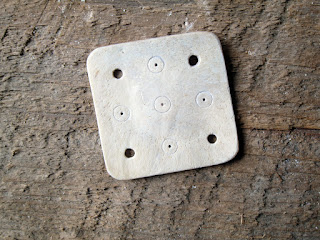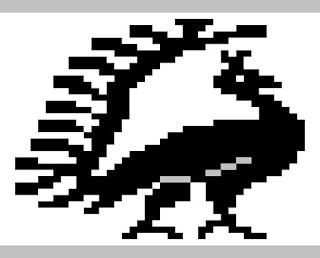Historical background
It is hard to say when or where tablet weaving was invented. As Peter Collingwood so aptly says: “a distinction has to be drawn between the earliest known fabrics that could have been tablet woven and those which in all probability were so woven.” In his book, he presents a chronological list of the most important historical finds from the earliest ones in bog burials in modern day Germany dating back as far as the 6th century BC to the year 1000 AD, after which too much material survives to make a brief summary feasible. He also gives a brief history of the most important archaeological finds of tablets. Existing remains of historical tablets show that they were made from a variety of materials, including wood, bone, antler, ivory, bronze and leather. The earliest tablets that were identified as used in tablet weaving come from a cave at El Gigarrelejo in Spain. They were the charred remains of four or five beach wood tablets, 3.0 cm square with four large holes. Nancy Spies (2000) gives a detailed list of existing tablets based on the type of material that they are made of. Figures 1 and 2 give some examples of bone and wooden tablets of various shapes.
Figure 1: Several examples of bone tablets found at Jarlshof in Shetland, at the Broch of Burrian on North Ronaldsay in Orkney, at Harbour Broch at Keiss in Caithness, at Keil Cave in Argyll and at Tain in Ross-shire. They are dated between 200 B.C and 400 A.D. Their sizes range from 3.2 cm for the smaller round tablets to 4.4 x 5.0 cm for the largest triangular tablet.
Figure 2: Wooden tablets from Antinoë, Egypt dated to the 4th to 5th century A.D.
Arguably the most famous example is shown in Figure 3, a linen brocaded band with its warp still threaded to a set of 52 tablets, found in the Oseberg ship burial in Norway and dated to the 9th century A.D.
Figure 3: A set of threaded tablet weaving tablets found in the Oseberg ship burial in Norway.
Material and design
The inspiration for my project was a bone tablet with incised decorations found at Alchester, England. The excessive thread marks in the corner holes suggest that this tablet was mostly used with four threads, one through each corner. The decorations punctured by the holes along the left and right edge of the tablet and the absence of noticeable thread marks there suggest that these two holes were added at a later time.
Figure 4: Bone tablet found at Alchester England; Roman (Asmolean Museum, Oxford).
These types of bone tablets were most likely made from the shoulder blades of domestic or hunted animals. Shoulder bones have a relatively flat and thin central part that is very suitable to making tablets. Since I had deer shoulder blades available to me, I decided to make the tablets from deer bone. As discussed below, I simplified the design a little due to the thinness of the central part of the shoulder bone. I decided to only incise single circles at the same locations as the double circles in the extant piece and to omit the others.
Making the tablets
The first tablet I made was a bit of a learning curve. I wanted to use tools that are as close to period as I can and we recently bought from Deagrad Tools in Sheffield, England, several hand forged ring and dot augers and a hand forged comb makers hacksaw based on the Mästermyr find (Gotland, Sweden, ca. 1000 A.D.). I started out with cutting off the thick piece of the shoulder bone with the hacksaw and that proved to be a mistake. Although the saw is specifically designed to saw through bone and antler, it proved too coarse for the much more delicate shoulder bone. When I was almost through, the thinner flat central part of the shoulder bone fractured due to the stress of the sawing action. There was still enough left to make one small tablet, but since the structure of the remaining part was already severely compromised I finished cutting it to size with a modern band saw.
I do not have period augers or spoon drills, so I experimented a bit with drilling holes in one of the leftover pieces by positioning the sharp point of a knife at the correct location for a hole and rotating the blade clockwise and counter clockwise under slight downward pressure. This proved surprisingly efficient and I had scraped out a nice round hole in no time. The edge and the rounded corners were shaped and smoothed using a modern file as a substitute for a period one (another item still on my tool wish list). The end result was a 3.5 cm square tablet with a hole in each of the corner (see Figure 6 on the right). Although a bit smaller than intended, well within the size range of bone tablets found in Roman Britain between the 1st and 4th century A.D.
Figure 6: The first completed tablet (undecorated).
Having learned from the earlier mistakes, I decided to try and make a second tablet without having to resort to a modern band saw. I cut a triangular slot from a board to support the thick parts of the shoulder blade. I then positioned the shoulder blade over the slot allowing me to cut out the thin flat center piece of bone with a fine dovetail saw (see Figure 7 below).
Figure 7: A saw jig to cut out the thin flat center piece from a shoulder blade.
This proved much more successful and I ended up with a nice thin and relatively flat triangle of bone large enough to cut a 4.2 x 4.2 cm square tablet. I then rounded off the corners, smoothed the edges and drilled the four holes in the same way as for the first tablet.
The final task was adding the incised decorations that drew my eye to the particular tablet found at Alchester, England (Figure 4 above). I first tried carving two concentric circles in a leftover part with two ring augers designed specifically for this task, a small one to carve the inner circle and a larger one for the outer circle. This immediately showed me that the larger auger created a center hole that would easily puncture completely through the thin bone tablet. So I decided to decorate the tablet only with smaller single circles at the same locations as the larger concentric double ones in the extant piece. I furthermore dispensed with the four additional smaller ones on the diagonals. The end result is a nice looking and fully functional bone tablet.
Figure 8: Cutting the tablet to size, rounding the corners and smoothing the edges, drilling the holes, and adding the decorations.
Learning points
Working with bone was an interesting new experience. It is much more fragile than I expected and has to be worked with care when using hand tools. Suitable tools make all the difference and the period hacksaw that we own proved too coarse for the task at hand. A modern, much finer dove tail saw was the solution, so I guess that just got added to my shopping list for period tools.
Find a downloadable version of this post at:
https://www.academia.edu/36500576/Making_bone_tablet_weaving_tablets
Bibliography
Arwidsson, Greta and Berg, Gosta (1999), The Mästermyr Find: A Viking Age Tool Chest from Gotland, Larson Publishing Company (Lompoc, CA)
Christensen, Arne Emil, and Nockert, Margareta (2006) Osebergfunnet – Bind IV Tekstilene, Museum of Cultural History (Oslo, Norway).
Collingwood, Peter (1982) The Techniques of Tablet Weaving, Echo Points Books & Media (Vermont).
Gillis, Carole, Nosch, Marie-Louise B. (ed.) (2003) Ancient Textiles: Production, Craft and Society. Proceedings of the First International Conference on Ancient Textiles, The Danish National Research Foundation Centre for Textiles, Oxbow Books (Oxford & Philadelphia).
Riley, Dennis (2014) Anglo-Saxon Tools, Anglo-Saxon Books, Lightning Source (Australia, England, USA).
Spies, Nancy (2000) Ecclesiastical Pomp & Aristocratic Circumstance - A Thousand Years of Brocaded Tabletwoven Bands, Arelate Studio (Maryland).






















